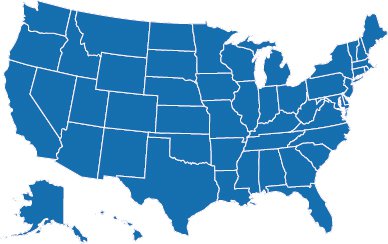
Keep up with the latest data and most popular content.
The US is a constitutional republic and representative democracy. Our Government is regulated by a system of checks and balances defined by the US Constitution, which serves as the country’s supreme legal document. In the US, citizens are usually subject to three levels of government: federal, state, and local. The original text of the Constitution establishes the structure and responsibilities of the federal government and its relationship with the individual states. The Constitution has been amended 27 times, including the first 10 amendments, the Bill of Rights, which forms the central basis of Americans’ individual rights.
The Constitution divides the federal government into three branches to ensure a central government in which no individual or group gains too much control:
Each branch of government can change acts of the other branches as follows:
Legislative
The legislative branch enacts legislation, confirms or rejects presidential appointments, and has the authority to declare war. This branch comprises Congress (the Senate and House of Representatives) and several agencies that provide support services to Congress.
The executive branch carries out and enforces laws. It includes the president, vice president, the Cabinet, 15 executive departments, independent agencies, and other boards, commissions, and committees.
The judicial branch interprets the meaning of laws, applies laws to individual cases, and decides if laws violate the Constitution. The judicial branch comprises the Supreme Court and other federal courts.
THE UNITED STATES GOVERNMENT
THE CONSTITUTION
LEGISLATIVE BRANCH
EXECUTIVE BRANCH
JUDICIAL BRANCH
THE CONGRESS
THE PRESIDENT
THE SUPREME COURT OF
SENATE | HOUSE
THE VICE PRESIDENT
THE UNITED STATES
EXECUTIVE OFFICE OF THE PRESIDENT
Architect of the Capitol
United States Botanic Garden
Government Accountability Office
Government Printing Office
Library of Congress
Congressional Budget Office
US Capitol Police
15 Cabinet Members
White House Office
Office of the Vice President
Council of Economic Advisers
Council on Environmental Quality
National Security Council
Office of Management and Budget
Office of National Drug Control Policy
Office of Policy Development
Office of Science and Technology Policy
Office of the US Trade Representative
United States Courts of Appeals
United States District Courts
United States Court of International Trade
United States Court of Federal Claims
Administrative Office of
the United States Courts
Federal Judicial Center
United States Sentencing Commission
SIGNIFICANT REPORTING ENTITIES (15)
DEPARTMENT OF DEFENSE
DEPARTMENT OF EDUCATION
DEPARTMENT OF ENERGY
DEPARTMENT OF HEALTH
AND HUMAN SERVICES
DEPARTMENT OF HOUSING AND URBAN
DEPARTMENT OF THE INTERIOR
DEPARTMENT OF JUSTICE
DEPARTMENT OF LABOR
DEPARTMENT OF STATE
DEPARTMENT OF TRANSPORTATION
DEPARTMENT OF THE TREASURY
DEPARTMENT OF VETERANS AFFAIRS
OTHER SIGNIFICANT REPORTING ENTITIES
Environmental Protection Agency
General Services Administration
National Aeronautics and Space Administration
National Science Foundation
Office of Personnel Management
Small Business Administration
Social Security Administration
US Agency for International Development
US Nuclear Regulatory Commission
Defense Security Cooperation Agency
Export-Import Bank of the United States
Farm Credit System Insurance Corporation
Federal Communications Commission
Federal Deposit Insurance Corporation
General Fund of the US Government
Millennium Challenge Corporation
National Credit Union Administration
Overseas Private Investment Corporation
Pension Benefit Guaranty Corporation
Railroad Retirement Board
Securities and Exchange Commission
Tennessee Valley Authority
US Postal Service
IN CONSERVATORSHIP
Fannie Mae Freddie Mac
SIGNIFICANT RELATED ENTITIES
The Federal Reserve
The Farm Credit System
Federal Home Loan Banks
For a discussion of each of the federal government departments and offices, please see The United States Government Manual at https://www.govinfo.gov/app/collection/GOVMAN.
Under the Tenth Amendment to the US Constitution, all powers not granted to the federal government are reserved to the states and the people. All state governments are modeled after the federal government and consist of three branches: executive, legislative, and judicial. The US Constitution mandates that states uphold a “republican form” of government, although the three-branch structure is not required.
Legislative
All 50 states have legislatures made up of elected representatives, who consider matters brought forth by the governor or introduced by its members to create legislation that becomes law. The legislature also approves a state’s budget and initiates tax legislation and articles of impeachment. The latter is part of a system of checks and balances among the three branches of government that mirrors the federal system and prevents any branch from abusing its power.
Every state except one has a bicameral legislature made up of two chambers: a smaller upper house and a larger lower house. Together the two chambers make state laws and fulfill other governing responsibilities. The smaller upper chamber is always called the Senate, and its members generally serve longer terms, usually four years. The larger lower chamber is most often called the House of Representatives, but some states call it the Assembly or the House of Delegates. Its members usually serve shorter terms, often two years. Nebraska is the lone state that has just one chamber in its legislature.
In every state, the executive branch is headed by a governor who is directly elected by the people. In most states, other leaders in the executive branch are also directly elected, including the lieutenant governor, the attorney general, the secretary of state, and auditors and commissioners. States reserve the right to organize in any way, so they often vary greatly with regard to executive structure. No two state executive organizations are identical.
Most states have a supreme court that hears appeals from lower-level state courts. Court structures and judicial appointments/elections are determined either by legislation or by the state constitution. The state supreme court usually focuses on correcting errors made in lower courts and therefore holds no trials. Rulings made in state supreme courts are normally binding; however, when questions are raised regarding consistency with the US Constitution, matters may be appealed directly to the United States Supreme Court.

STATE GOVERNMENTS (50)